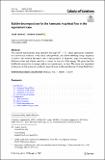| dc.contributor.author | Jendrej, Jacek | |
| dc.contributor.author | Lawrie, Andrew | |
| dc.date.accessioned | 2023-11-06T16:25:13Z | |
| dc.date.available | 2023-11-06T16:25:13Z | |
| dc.date.issued | 2023-11-02 | |
| dc.identifier.uri | https://hdl.handle.net/1721.1/152907 | |
| dc.description.abstract | Abstract
We consider the harmonic map heat flow for maps
$$\mathbb {R}^{2} \rightarrow \mathbb {S}^2$$
R
2
→
S
2
, under equivariant symmetry. It is known that solutions to the initial value problem can exhibit bubbling along a sequence of times—the solution decouples into a superposition of harmonic maps concentrating at different scales and a body map that accounts for the rest of the energy. We prove that this bubble decomposition is unique and occurs continuously in time. The main new ingredient in the proof is the notion of a collision interval from Jendrej and Lawrie (J Amer Math Soc). | en_US |
| dc.publisher | Springer Berlin Heidelberg | en_US |
| dc.relation.isversionof | https://doi.org/10.1007/s00526-023-02597-1 | en_US |
| dc.rights | Creative Commons Attribution | en_US |
| dc.rights.uri | https://creativecommons.org/licenses/by/4.0/ | en_US |
| dc.source | Springer Berlin Heidelberg | en_US |
| dc.title | Bubble decomposition for the harmonic map heat flow in the equivariant case | en_US |
| dc.type | Article | en_US |
| dc.identifier.citation | Calculus of Variations and Partial Differential Equations. 2023 Nov 02;62(9):264 | en_US |
| dc.contributor.department | Massachusetts Institute of Technology. Department of Mathematics | |
| dc.identifier.mitlicense | PUBLISHER_CC | |
| dc.eprint.version | Final published version | en_US |
| dc.type.uri | http://purl.org/eprint/type/JournalArticle | en_US |
| eprint.status | http://purl.org/eprint/status/PeerReviewed | en_US |
| dc.date.updated | 2023-11-05T04:12:04Z | |
| dc.language.rfc3066 | en | |
| dc.rights.holder | The Author(s) | |
| dspace.embargo.terms | N | |
| dspace.date.submission | 2023-11-05T04:12:04Z | |
| mit.license | PUBLISHER_CC | |
| mit.metadata.status | Authority Work and Publication Information Needed | en_US |
